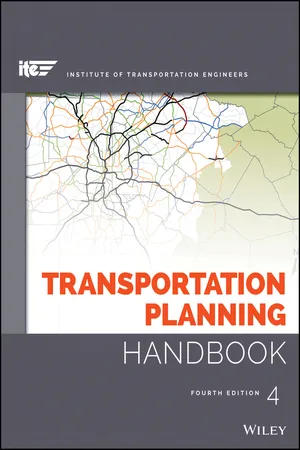
- English
- ePUB (mobile friendly)
- Available on iOS & Android
Transportation Planning Handbook
About this book
A multi-disciplinary approach to transportation planning fundamentals
The Transportation Planning Handbook is a comprehensive, practice-oriented reference that presents the fundamental concepts of transportation planning alongside proven techniques. This new fourth edition is more strongly focused on serving the needs of all users, the role of safety in the planning process, and transportation planning in the context of societal concerns, including the development of more sustainable transportation solutions. The content structure has been redesigned with a new format that promotes a more functionally driven multimodal approach to planning, design, and implementation, including guidance toward the latest tools and technology. The material has been updated to reflect the latest changes to major transportation resources such as the HCM, MUTCD, HSM, and more, including the most current ADA accessibility regulations.
Transportation planning has historically followed the rational planning model of defining objectives, identifying problems, generating and evaluating alternatives, and developing plans. Planners are increasingly expected to adopt a more multi-disciplinary approach, especially in light of the rising importance of sustainability and environmental concerns. This book presents the fundamentals of transportation planning in a multidisciplinary context, giving readers a practical reference for day-to-day answers.
- Serve the needs of all users
- Incorporate safety into the planning process
- Examine the latest transportation planning software packages
- Get up to date on the latest standards, recommendations, and codes
Developed by The Institute of Transportation Engineers, this book is the culmination of over seventy years of transportation planning solutions, fully updated to reflect the needs of a changing society. For a comprehensive guide with practical answers, The Transportation Planning Handbook is an essential reference.
Frequently asked questions
- Essential is ideal for learners and professionals who enjoy exploring a wide range of subjects. Access the Essential Library with 800,000+ trusted titles and best-sellers across business, personal growth, and the humanities. Includes unlimited reading time and Standard Read Aloud voice.
- Complete: Perfect for advanced learners and researchers needing full, unrestricted access. Unlock 1.4M+ books across hundreds of subjects, including academic and specialized titles. The Complete Plan also includes advanced features like Premium Read Aloud and Research Assistant.
Please note we cannot support devices running on iOS 13 and Android 7 or earlier. Learn more about using the app.
Information
Chapter 1
Introduction to Transportation Planning1
I. INTRODUCTION
II. ORGANIZATION OF THIS HANDBOOK
- What is transportation planning?
- Chapter 1: Introduction to Transportation Planning
- What are the basic concepts for understanding transportation systems and their relationship to the community?
- Chapter 2: Travel Characteristics and Data
- Chapter 3: Land Use and Urban Design
- Chapter 4: Environmental Considerations
- Chapter 5: Transportation Finance and Funding
- What are the types of tools and analysis methods used in transportation planning?
- Chapter 6: Travel Demand and Network Modeling
- Chapter 7: Evaluation and Prioritization Methods
- Chapter 8: Asset Management
- How does one plan for mode-specific transportation networks?
- Chapter 9: Road and Highway Planning
- Chapter 10: Transportation System Management and Operations
- Chapter 11: Planning for Parking
- Chapter 12: Transit Planning
- Chapter 13: Planning for Pedestrians and Bicyclists
- Chapter 14: Travel Demand Management
- How does one plan for multimodal transportation networks?
- Chapter 15: Statewide Transportation Planning
- Chapter 16: Metropolitan Transportation Planning
- Chapter 17: Corridor Planning
- Chapter 18: Local and Activity Center Planning
- Chapter 19: Site Planning and Impact Analysis
- Chapter 20: Rural Community and Tribal Nation Planning
- Chapter 21: Recreational Areas
- What are some special planning applications transportation planners should know about?
- Chapter 22: Integrating Freight into the Transportation Planning Process
- Chapter 23: Playing it Safe—Safety Considerations in the Transportation Planning Process
- Chapter 24: Public Participation and Engagement
III. THE TRANSPORTATION PLANNING PROCESS

A. Major Steps in Transportation Planning
Table of contents
- Cover
- Title Page
- Copyright
- Table of Contents
- Preface
- Acknowledgments
- About the Editor
- Chapter 1: Introduction to Transportation Planning
- Chapter 2: Travel Characteristics and Data
- Chapter 3: Land Use and Urban Design
- Chapter 4: Environmental Considerations
- Chapter 5: Transportation Finance and Funding
- Chapter 6: Travel Demand and Network Modeling
- Chapter 7: Evaluation and Prioritization Methods
- Chapter 8: Asset Management
- Chapter 9: Road and Highway Planning
- Chapter 10: Transportation System Management and Operations
- Chapter 11: Planning for Parking
- Chapter 12: Transit Planning
- Chapter 13: Planning for Pedestrians and Bicyclists
- Chapter 14: Travel Demand Management
- Chapter 15: Statewide Transportation Planning
- Chapter 16: Metropolitan Transportation Planning
- Chapter 17: Corridor Planning
- Chapter 18: Local and Activity Center Planning
- Chapter 19: Site Planning and Impact Analysis
- Chapter 20: Rural Community and Tribal Nation Planning
- Chapter 21: Recreational Areas
- Chapter 22: Integrating Freight into the Transportation Planning Process
- Chapter 23: Planning It Safe-Safety Considerations in the Transportation Planning Process
- Chapter 24: Public Participation and Engagement
- Index
- End User License Agreement